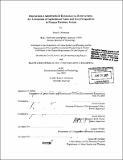Household adoption of ecological sanitation : an assessment of agricultural value and user perspectives in Nyanza Province, Kenya
Author(s)
Robinson, Brian E. Massachusetts Institute of Technology
DownloadFull printable version (15.12Mb)
Other Contributors
Massachusetts Institute of Technology. Dept. of Civil and Environmental Engineering.
Advisor
JoAnn Carmin and Susan Murcott.
Terms of use
Metadata
Show full item recordAbstract
Ecological sanitation, or ecosan, refers to a range of sanitation technologies in which human excreta is recovered and retained on-site, and eventually reused. However, when a culture does not have a tradition of reusing or handling human waste, what would motivate a household within that culture to recycle and reuse their waste? More specifically, how do the agricultural value of the material from an ecosan toilet and user perspectives on ecosan systems influence households' adoption of ecosan toilets? On average, households in the study area produce 4 kilograms of nitrogen and 0.6 kilograms of phosphorous per year from urine collected in the skyloo toilet, the type of urine-diverting ecosan toilet available in the study area in the Nyanza Province, Kenya. These nutrients are the equivalent of a cost savings of about US $12 per year (the GDP per capita in Kenya in 2004 was US $1 100). About two-thirds of the households reuse the processed feces and urine in household gardens. Users reported additional major benefits such as the absence of foul odors, inexpensive construction costs (partly due to a materials subsidy by the promoting NGO), and the aesthetic value/social status that the facility brings to the owners' homes. (cont.) The major negative factors included problems with construction and design of the facility, training new users-especially children-how to use the toilet, and handling human excrement. The findings suggest that ecosan is a viable sanitation option that fills a niche within this region of Kenya. Ecosan's comparative advantages seem to be significant enough to outweigh negative cultural sentiments regarding the handling of human excrement to some user groups. Such user groups include the very poor who practice household agriculture (those who have trouble affording commercial fertilizer and also have reason to want it), those who live in areas with high nutrient loads to natural waters, households with an exceptional environmental conscious, and households in which adverse hydrogeologic conditions (such as a high water table or loose soils) make pit latrines an environmental and human health hazard. In addition to household-level advantages, the niche that ecosan fills has the potential to make headway towards the Millennium Development Goals' provision of sanitation, and to be a valuable contribution to integrated water resource management strategies.
Description
Thesis (M.C.P.)--Massachusetts Institute of Technology, Dept. of Urban Studies and Planning; and, (M. Eng.)--Massachusetts Institute of Technology, Dept. of Civil and Environmental Engineering, 2005. Includes bibliographical references (p. 105-111).
Date issued
2005Department
Massachusetts Institute of Technology. Department of Civil and Environmental Engineering; Massachusetts Institute of Technology. Department of Urban Studies and PlanningPublisher
Massachusetts Institute of Technology
Keywords
Urban Studies and Planning., Civil and Environmental Engineering.